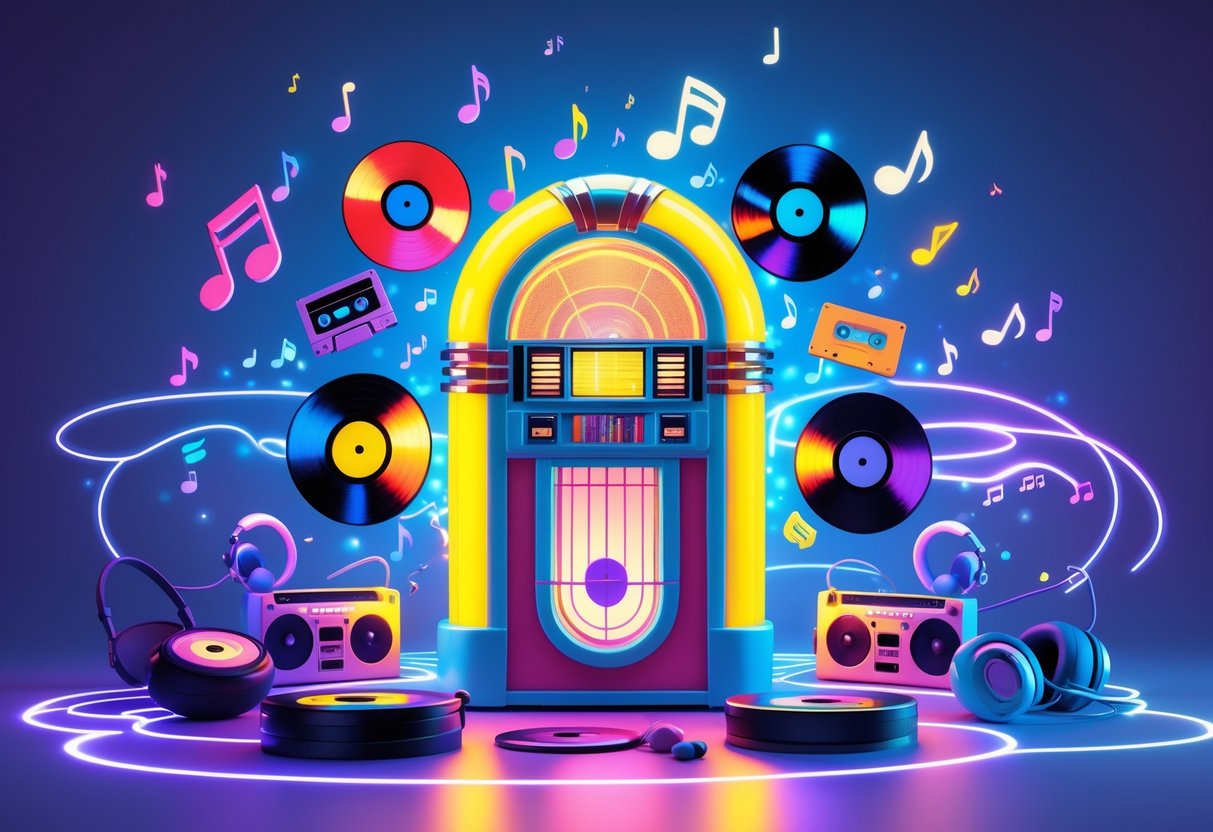One-Hit Wonders: Hits That Defined Eras and Artists
Updated On: November 13, 2025 by Aaron Connolly
What Is a One-Hit Wonder?

A one-hit wonder is basically a music artist who grabs mainstream attention with just one big song, but never really manages to repeat that magic. People remember them for that single flash of fame, while the rest of their work fades into the background or just doesn’t catch on.
Defining One-Hit Wonders in Music
The music industry actually has a pretty specific way of defining these artists. Billboard magazine says a one-hit wonder is “an artist that cracks the top 40 on the Billboard Hot 100 and never makes it back to that position.”
That’s all about chart numbers, not talent. Someone might put out dozens of songs, but if only one makes it to the top 40, they get labeled a one-hit wonder.
Music journalist Wayne Jancik, in The Billboard Book of One-Hit Wonders, describes them as acts that land “a position on national, pop, Top 40 record chart just once.”
Heads up: Sometimes people call artists one-hit wonders even though they had hits in other countries. The “one-hit” label might only stick in places like the US or UK.
People often use the term as a bit of a jab. It kind of implies the artist couldn’t deliver more than that one memorable tune.
Origins of the Term
The phrase “one-hit wonder” popped up as the music industry started caring more about chart stats and commercial success. Radio stations and record labels began tracking which songs hit the top 40 over and over.
When the Billboard Hot 100 launched in 1958, it got a lot easier to spot artists who only had a brief taste of mainstream popularity.
You can find one-hit wonders in every decade. Norman Greenbaum gave us “Spirit in the Sky” in 1969, and Gotye dropped “Somebody That I Used to Know” in 2011.
Quick tip: If you check out the Official Charts Company lists, you’ll notice the definition of one-hit wonders shifts depending on the decade and the region.
Criteria for Inclusion
A few things decide whether someone really counts as a one-hit wonder:
Chart Position Requirements:
- The artist needs to reach the top 40 on a national chart.
- Only one song makes it that far.
- No follow-up hits reach the same level.
Geographic Considerations: Some artists are one-hit wonders in one country but rack up multiple hits elsewhere. Nena’s “99 Luftballons” made her a one-hit wonder in English-speaking countries, but she kept making hits in Germany.
Time Frame Factors: There’s no set time limit. If an artist returns to the charts years later, they can lose their one-hit wonder status.
Exclusions: Artists with more than one top 40 hit don’t count, even if one song totally overshadows the rest. Acts that never cracked the top 40 but got popular in other ways (like “turntable hits”) kind of blur the lines.
Some lists only include acts whose only top 75 charting record was a number one hit. That’s a pretty exclusive club.
Famous One-Hit Wonders Across Decades

The most unforgettable one-hit wonders seem to capture their era’s mood perfectly. Norman Greenbaum’s spiritual rock, Gotye’s indie heartbreak—these songs ruled the charts, then their creators faded from the mainstream.
1970s Breakout Hits
Norman Greenbaum dropped “Spirit in the Sky” in 1970, and it became a rock anthem for the ages. That guitar riff and gospel vibe just hit the spot.
He never managed to reach those heights again. Decades later, the song still pops up everywhere.
Wild Cherry got everyone moving with “Play That Funky Music” in 1976. That disco-rock groove really nailed the party scene.
The band just couldn’t repeat that success. Later singles barely made a dent.
Ram Jam took “Black Betty” from folk roots to rock radio in 1977. The heavy guitar turned an old work song into something new.
Ram Jam’s momentum fizzled out after that. Most people only know them for that one track.
Rupert Holmes ended the decade with “Escape (The Piña Colada Song)” in 1979. The song’s story and tropical feel made it an instant favorite.
1980s Iconic Tracks
The Knack burst onto the scene with “My Sharona” in 1979, and the buzz carried into the early ’80s. That power-pop hook was everywhere.
The Buggles made history with “Video Killed the Radio Star” in 1979. MTV picked it as their very first music video in 1981.
A-ha’s “Take on Me“ owned 1985 with its synth-pop sound and wild animated video. Those falsetto vocals and electronic beats? Pure ’80s.
Tony Basil brought some cheerleader fun to the charts with “Mickey” in 1982. The chant and high-energy video made it impossible to ignore.
Soft Cell’s “Tainted Love” took a forgotten soul song and turned it into a synth-pop staple in 1981. Their version is still instantly recognizable.
German band Nena broke through language barriers with “99 Luftballons” in 1983. Both the German and English versions blew up.
1990s and 2000s Chart Surprises
Vanilla Ice brought hip-hop to the mainstream with “Ice Ice Baby“ in 1990. The Queen and David Bowie sample stirred up both excitement and lawsuits.
Chumbawamba nailed working-class resilience with “Tubthumping“ in 1997. That “I get knocked down, but I get up again” chorus stuck in everyone’s head.
Lou Bega gave us a taste of 1940s Cuba with “Mambo No. 5” in 1999. He took Pérez Prado’s original and made it a global dance hit.
The Baha Men unleashed “Who Let the Dogs Out” in 2000. That party anthem took over sports events and parties everywhere.
Dexys Midnight Runners scored big with “Come on Eileen” in 1982, and the song kept its popularity for years. The folk-rock vibe really set it apart.
Gotye nailed modern heartbreak with “Somebody That I Used to Know” in 2011. That indie-pop sound and raw emotion just resonated worldwide.
Genres That Birthed One-Hit Wonders

Some music genres just seem to crank out one-hit wonders. New wave’s weirdness, disco’s mass appeal, and hip-hop’s crossover moments all gave unknown artists a shot at the big time—at least once.
New Wave and Synth-Pop
New wave exploded in the late ’70s as artists started playing around with synths and electronic sounds. The genre’s experimental vibe made it a hotspot for one-hit wonders.
Soft Cell totally nailed it with “Tainted Love” in 1981. Their moody, electronic cover of a soul song became a worldwide hit. Even though they put out more albums, nothing else caught on like that.
Devo showed Americans could do new wave too with “Whip It” in 1980. Their quirky style and robotic moves grabbed attention. The song hit number 14 on the Billboard Hot 100, but that was their only big one.
“Video Killed the Radio Star” by The Buggles became MTV’s first music video in 1981. This synth-pop jam summed up the era’s tech obsession. They ruled the charts for a bit, then faded out.
New wave’s focus on visuals and electronic sounds made it easier for new acts to break through. But honestly, keeping that momentum going proved tough for most.
Disco Fever
Disco ruled the ’70s, and it created a bunch of one-hit wonders. The genre was all about the beat and the dance floor—if you had a catchy hook, you could blow up overnight.
Studio musicians cranked out disco tracks for clubs and radio. Most of them didn’t even plan to become stars; they just wanted to get people dancing.
Record labels signed almost anyone with a good groove. Production mattered more than having a unique voice or style. A lot of hits came from folks who saw disco as a quick payday.
Disco’s formula was pretty straightforward. That four-on-the-floor beat, strings, and heavy bass made it easy to craft a hit. You didn’t need to reinvent the wheel.
When disco crashed around 1980, a lot of these artists vanished. Their careers were tied to a trend, not a lasting sound.
Hip-Hop Crossover Moments
Hip-hop’s move into the mainstream gave rise to a bunch of one-hit wonders. Artists who managed to mix underground rap with pop often couldn’t pull off a second big hit.
Early hip-hop stars had to win over totally different crowds. Underground respect didn’t always mean mainstream success. Some rappers just got stuck in between.
Novelty rap tracks especially took off. If you had a catchy hook or a dance, you could blow up on radio and MTV—but following up was another story.
Hip-hop changed fast. What worked in 1985 sounded old by 1990. Artists couldn’t just copy their formula and expect another hit.
Fans cared a lot about authenticity too. If artists seemed like they were chasing fame instead of being real, people moved on pretty quick.
The Role of the Billboard Hot 100 and Top 40

The Billboard Hot 100 is really the main scoreboard for one-hit wonders. Most artists need to break into the Top 40 to earn that title. If you don’t hit the charts, hardly anyone remembers you.
Chart Success as a Marker
The Top 40 line is where most people draw the line for one-hit wonders. The general rule? You get the label if you reach the Top 40 only once.
That’s a pretty clear cutoff. If your song peaks at 41 or lower, you usually don’t make the list.
The Billboard Hot 100 uses a points system for different chart spots. Number one gets you the most points. Lower spots don’t carry as much weight.
Chart runs looked really different in past decades. Songs used to stick around a lot longer than they do now.
Recent one-hit wonders like GAYLE’s “abcdefu” (number 3) and Masked Wolf’s “Astronaut in the Ocean” (number 6) show how streaming, especially through TikTok, shakes up the charts.
Baauer’s “Harlem Shake” hit number one for five weeks, but he never got back to the Top 40.
Billboard Criteria and Recognition
The Billboard Hot 100 figures out chart spots by mixing sales, radio plays, and streaming data. The formula has changed a lot since the chart started.
These days, streams count, but not as much as a sale or radio spin. It’s all weighted differently.
You only get one-hit wonder status if you’re the main artist. If you’re just featured or singing backup, it doesn’t count.
Changes in how Billboard tracks hits make a big difference. When YouTube plays started counting in 2013, viral hits like “Harlem Shake” shot up the charts.
Some legendary acts technically count as one-hit wonders. Jimi Hendrix, Janis Joplin, and Rush each landed in the Top 40 only once.
The 21st century seems to pump out one-hit wonders in a new way. TikTok hits usually go viral, blow up on streaming, and then hit radio.
Billboard treats movie soundtrack hits a little differently. Anna Kendrick’s “Cups” from Pitch Perfect made it to number 6, even though she’s mostly known as an actress, not a singer.
Notable One-Hit Wonder Artists

Some of music’s most unforgettable songs come from artists who managed to catch lightning in a bottle—just once. These three artists show how a single track can shape an entire career, from Norman Greenbaum’s unexpected gospel anthem, to The Knack’s catchy new wave hit, and Toni Basil’s cheerleader-inspired pop moment.
Norman Greenbaum’s Unlikely Gospel Hit
Norman Greenbaum wrote “Spirit in the Sky” in 1969 and turned it into one of rock’s most lasting anthems. Oddly enough, a Jewish musician from Massachusetts found his inspiration while watching Porter Wagoner on TV.
He mixed gospel themes with fuzzy guitar effects, creating a sound that felt totally new at the time. That heavy guitar, paired with spiritual lyrics, made the song stand out.
Key Facts about “Spirit in the Sky”:
- Hit No. 3 on the Billboard Hot 100
- Used that wild fuzztone guitar all the way through
- Written after Greenbaum watched country gospel on TV
- Even became a one-hit wonder twice—Doctor & the Medics covered it in 1986
Greenbaum tried to follow up with a song called “Canned Ham.” He really jumped topics there, but the track didn’t chart at all. That pretty much locked in his one-hit wonder status.
The Knack and the Power of ‘My Sharona’
The Knack crashed onto the scene in 1979 with “My Sharona.” That power-pop anthem took over the airwaves and basically defined their whole career.
Everything great about late ’70s rock is in there: the energy, those sticky guitar riffs, and a chorus that just won’t leave your head. The song held onto the number one spot on the Billboard Hot 100 for six weeks.
Doug Fieger wrote it about Sharona Alperin, a real person he actually met. The bass and drums drive the whole thing, and radio stations just couldn’t get enough.
“My Sharona” Achievements:
- Six weeks at No. 1 on Billboard Hot 100
- Became the best-selling US single of 1979
- Certified gold by the RIAA
- Berton Averre’s guitar solo is still iconic
Despite putting out more albums, The Knack never came close to that kind of success again. They’re a textbook example of how one huge hit can overshadow everything else you do.
Toni Basil: Choreographer Turned Pop Star
Toni Basil brought her dance chops into pop music with “Mickey” in 1982. Even with her long career in entertainment, this song was really her only big hit.
Before she started recording, Basil worked as a choreographer and dancer. She showed up in movies and collaborated with major artists behind the scenes. That background totally shaped her approach to “Mickey.”
She actually covered the song—it was originally “Kitty” by UK band Racey. Basil changed the lyrics’ gender and added her own cheerleader-style choreography.
“Mickey” Success Story:
- Hit No. 1 in the US and several other countries
- Music video featured those iconic cheerleader outfits
- Showed off Basil’s pro dance skills
- Became a symbol of 1980s pop culture
The music video played a huge role in the song’s popularity. MTV had it on heavy rotation in the early days. Basil’s cheerleader look and high-energy moves became instantly recognisable.
Her later singles just didn’t catch on. “Mickey” is a great example of how timing, video, and performance can combine to create a one-hit wonder that defines a decade.
Songs That Shaped Pop Culture

Some one-hit wonders didn’t just top the charts—they actually changed how we experience music and entertainment. Certain tracks launched whole industries, became movie touchstones, and even gave us phrases we still toss around today.
Music Videos and MTV Launches
MTV kicked off on August 1, 1981, with The Buggles’ “Video Killed the Radio Star.” That one-hit wonder literally launched the music video revolution. The song’s message ended up being weirdly prophetic, as visuals started mattering just as much as the music.
In MTV’s early days, plenty of one-hit wonders mastered the music video format. Artists like M with “Pop Muzik” paired catchy synth-pop with unforgettable visuals.
Music videos kept these songs alive long after radio moved on. If you had a creative video, people remembered your song—even if you never had another hit.
That shift stuck around. Today’s streaming and social media platforms still run with MTV’s visual-first approach to music.
Songs in Film and Television
Filmmakers love using one-hit wonders as soundtracks—they’re instantly recognisable, and licensing them doesn’t break the bank. Lou Bega’s “Mambo No. 5” showed up in tons of movies, ads, and TV shows in the early 2000s.
These tracks work as musical time machines. Drop in “Pop Muzik” and suddenly it’s the late ’70s, or play a ’90s dance hit and everyone’s transported back.
Wedding DJs and party organisers can count on these crowd-pleasers. “Mambo No. 5” still gets people moving at celebrations everywhere because, honestly, who doesn’t know it?
Their quick flash of fame made them affordable for small productions, but they still packed a cultural punch.
Cultural Catchphrases and References
Baha Men’s “Who Let the Dogs Out” gave us one of the catchiest phrases in pop history. That simple question turned into shorthand for chaos or excitement—especially at sports games and parties.
Some of these hooks outlive the artists themselves. People quote the lines without even remembering the full song or who sang it.
Social media has only made this trend bigger. Viral TikTok trends often dig up one-hit wonder lyrics for memes and challenges.
These phrases sneak into our everyday language, proof that sometimes one great hook means more than a whole album’s worth of songs.
Behind the Scenes: Why Artists Become One-Hit Wonders
The music industry can be brutal. Even seriously talented artists often can’t repeat their first big success. Shifting audience tastes, industry barriers, and the challenge of turning one great song into a real career all play a part.
Changing Trends and Tastes
Fans’ preferences change fast, and artists who can’t keep up get left behind. What’s huge one year might sound dated just months later.
A lot of one-hit wonders capture a really specific moment in pop culture. Take Chamillionaire’s “Ridin’” from 2005. It hit number one and stuck around for 31 weeks because it spoke to something people cared about at the time.
But catching that kind of cultural magic twice? Honestly, it’s almost impossible. You can’t fake the authenticity that made the first hit special.
Genres evolve, too. The grunge wave of the ’90s gave us 4 Non Blondes’ “What’s Up?” But as music tastes shifted, some artists just couldn’t keep up.
Radio and streaming services always want the next big thing. Yesterday’s hit quickly turns into today’s nostalgia, no matter how talented you are.
Industry Barriers and Challenges
Record labels have to pick where to spend their money. Supporting a second single can cost as much as launching someone brand new.
Commercial success often depends on label support. Without strong promotion, even a great follow-up song might not reach listeners.
Radio play is still important. Program directors don’t want to risk airtime on artists whose last single didn’t perform.
Streaming has made things trickier. Getting onto big playlists can make or break a song, but landing those spots often requires connections and marketing power that fade after your first hit.
Distribution and promo contracts usually favour new artists. Labels would rather chase fresh potential than try to revive an act whose momentum has stalled.
One Hit Versus Sustained Success
Writing one unforgettable song is a different skill from building a career. Some artists are amazing at capturing a moment, but the business side of music history trips them up.
Sustained success takes constant creativity, a solid team, and the ability to change with the times. Linda Perry from 4 Non Blondes, for example, found more lasting success by writing hits for others—like Pink’s “Get the Party Started.”
Chasing that first big win can mess with your head. The pressure leads some artists to overthink their next moves, losing the spark that made their hit special.
Some smart one-hit wonders move behind the scenes. Elliot Lurie from Looking Glass ended up running music at 20th Century Fox. Joe Budden, after his rap hit, built a podcasting empire worth over £16 million.
Leveraging that first taste of fame into something sustainable—whether it’s songwriting, producing, or business—often works better than trying to chase the charts again.
Legacy and Lasting Influence of One-Hit Wonders

One-hit wonders still shape music culture long after their brief time at the top. Their influence pops up in nostalgia revivals and inspires new artists looking for that same spark.
Revivals and Nostalgia
One-hit wonders have a knack for making comebacks through movies, TV ads, and anniversary events. These tracks lock in a moment in music history and bring out strong feelings years later.
Movies love to use forgotten hits to set the scene. “Come on Eileen” by Dexys Midnight Runners found a whole new audience in 2000s film soundtracks. DJs at weddings and parties still lean on these instantly recognisable songs.
MTV made a big impact by tying songs to memorable videos. The channel’s ’80s programming helped cement those images. When these tracks come back, the visuals are just as important as the music, which makes the nostalgia hit even harder in today’s pop culture.
Streaming services and TikTok introduce these songs to younger listeners. Throwback playlists and viral clips give one-hit wonders a fresh shot at relevance. Plenty of people discover these tracks without ever knowing their chart stories.
The nostalgia business jumps on this connection. Tribute bands and themed festivals let people relive whole decades through their favourite one-hit wonders.
Sampling and Covers by Later Artists
Modern producers love sampling one-hit wonders for new tracks. Hip-hop especially grabs these familiar hooks—they’re an easy way to connect with listeners across generations.
Those original melodies give new songs a built-in emotional punch. Producers know a good sample can make a track instantly memorable.
Covers pop up everywhere, from talent shows to social media. Audiences already know the tunes, so new artists can put their own spin on them and still get a reaction.
Gospel musicians have even covered some of these hits, turning secular songs into worship anthems. It’s wild how these melodies can cross genres and find new life.
Sometimes a cover version actually outshines the original. That just proves how much staying power a great one-hit wonder really has.
Comparisons with Career Multi-Hit Artists

Multi-hit artists usually build up a diverse body of work before their first big moment, while one-hit wonders often don’t have that creative foundation. That difference shapes their whole journey and how we remember them in pop culture.
The Beatles as Multi-Hit Icons
The Beatles are the gold standard for multi-hit artists. They racked up over 20 number-one hits, shifting styles and sounds with each new release.
They kept things fresh by always experimenting. Each album showed real growth and a willingness to take risks. From “Love Me Do” to “Come Together,” they never stuck to one formula.
Key factors in their sustained success:
- Creative diversity—rock, ballads, and plenty of weird experiments
- Strong Lennon-McCartney songwriting partnership
- Constantly evolving to match musical trends
- Individual talents that balanced each other out
The Beatles played loads of live shows before fame found them. That gave them a solid creative base to draw on throughout their career.
Contrast in Fame and Longevity
One-hit wonders run into a whole different set of problems than artists like The Beatles. That single big song often ends up feeling more like a creative trap than a springboard.
Fame differences:
| One-Hit Wonders | Multi-Hit Artists |
|---|---|
| Instant but brief recognition | Gradual, lasting fame |
| Defined by one song | Known for body of work |
| Limited creative expectations | Pressure to innovate |
Multi-hit artists get to experiment more because their fans already trust them. People expect them to try new sounds since they’ve shown their range.
One-hit wonders usually find themselves stuck repeating the same sound. Record labels and fans keep asking for more of the same, and adapting to new trends becomes nearly impossible.
A diverse creative portfolio helps artists survive shifting pop culture. If they don’t have that foundation, they often fade away when musical tastes change.
Grammy Nominations and Industry Recognition

A surprising number of one-hit wonders have snagged Grammy nominations, even with just one big chart hit. Gotye, for example, took over the world with “Somebody That I Used to Know” and grabbed both commercial and critical success. Others earned Grammy nods even if their Billboard run was pretty modest.
Notable Grammy-Nominated One-Hit Wonders
Some one-hit wonders have actually won major Grammy Awards. Bobby McFerrin’s “Don’t Worry Be Happy” picked up Record of the Year and Song of the Year in 1988. That song hit number one and remains McFerrin’s only big pop moment.
Norah Jones won five Grammys in 2003 for “Don’t Know Why.” Her debut swept the awards, even though the single peaked at just number 30.
Other Grammy-winning one-hit wonders:
- Domenico Modugno – “Volare” (Record and Song of the Year, 1958)
- Starland Vocal Band – “Afternoon Delight” (Best New Artist, 1976)
- Shawn Colvin – “Sunny Came Home” (Record and Song of the Year, 1997)
Gotye’s “Somebody That I Used to Know” basically owned the 2013 Grammys. It won Best Pop Duo/Group Performance and Record of the Year, while the song held the top spot for eight weeks.
Critical Versus Commercial Success
Grammy recognition doesn’t always lead to lasting commercial impact. Plenty of Grammy-nominated one-hit wonders get critical praise but struggle to stay on the charts.
Les Crane picked up Best Spoken Word Recording in 1971 for “Desiderata.” That philosophical spoken-word track reached number eight, but it was Crane’s only real musical highlight.
Some artists actually chose to stick with their artistic instincts over chasing hits. Shawn Colvin’s folk-influenced music got critical love, but her later albums went for a smaller, dedicated audience instead of mainstream radio play.
Grammy categories often reward:
- Innovation in production or arrangement
- Cultural impact beyond chart position
- Artistic merit over commercial formula
The Recording Academy loves to spotlight breakthrough moments that define a musical era, even if the artist can’t match that success again.
Fun Facts and Trivia About One-Hit Wonders

One-hit wonders tend to have wild stories behind their brief fame. Some artists found global success with songs they never meant as singles, while others managed to keep working long after their one big hit.
Unexpected Global Hits
Some of the most famous one-hit wonders happened almost by accident. Iron Butterfly’s “In-a-Gadda-Da-Vida” started off as a quick 90-second tune called “In the Garden of Eden.”
The singer was so drunk during rehearsal that he slurred the title, and the band just ran with it, stretching the track to 17 minutes.
Steam’s “Na Na Hey Hey Kiss Him Goodbye” came out of a single session as nothing more than filler. The “na na” part was supposed to be temporary, but they never replaced it.
That song hit number one in America for two weeks in 1969. These days, it’s basically the anthem for fans booting losing teams out of the stadium.
Norman Greenbaum wrote “Spirit in the Sky” as a joke after watching gospel music on TV. He thought the style was funny and wrote his version in under 20 minutes. The song ended up one of 1970’s biggest, sitting at number three for 15 weeks.
Artists’ Later Careers
A lot of one-hit wonders took unexpected paths after their big moment. The Zombies actually broke up after their album flopped in Britain, but then “Time of the Season” blew up in America a year later.
They got back together and have been performing for decades, turning one hit into a long career.
Question Mark and the Mysterians made what many people call the first garage rock number one. “96 Tears” is often credited with helping launch punk, and Rudy Martinez still performs as Question Mark all these years later.
The Foundations recorded “Build Me Up Buttercup” with a brand new lead singer who’d just joined the band. They broke up two years later, but the song stuck around and still pops up in movies and ads.
Some artists just leaned into their one-hit status. Norman Greenbaum left music and found success as a restaurateur, pretty happy with his one big hit.
Songs With Lasting Appeal
One-hit wonders sometimes outlast the careers of artists with a string of hits. “Build Me Up Buttercup” shows up in movies and commercials and is still instantly recognizable after more than five decades.
“Spirit in the Sky” gets covered all the time and pops up in soundtracks. Its catchy, simple style makes it a go-to for ads and sports.
“96 Tears” influenced entire genres. Punk and garage bands still talk about it as a major inspiration, especially that unmistakable organ riff.
“Brandy (You’re a Fine Girl)” got so popular in Washington D.C. that local stations played it constantly. DJs said they’d never seen such a response, and Epic Records signed the band just based on the regional hype.
These songs work because they’re catchy right away. Simple choruses, a strong hook, and a real emotional punch—these tracks do what many big artists spend their whole careers chasing: genuine cultural impact.
Frequently Asked Questions

People get curious about what makes some artists land just one hit and others keep going. The most common questions seem to revolve around memorable tracks from the 70s to the 2010s, and why these musical flukes even happen.
Who are some of the most memorable one-hit wonders from the 2000s?
The 2000s gave us a handful of unforgettable one-hit wonders that still play on the radio. Gotye and Kimbra absolutely ruled with “Somebody That I Used to Know” in 2011, and it stuck around the charts for 44 weeks.
“Hips Don’t Lie” by Shakira and Wyclef Jean became a global smash in 2006. Shakira already had hits, but for Wyclef, it was his only major solo moment after the Fugees.
Crazy Town’s “Butterfly” hit number one in 2001. That song sampled Red Hot Chili Peppers and became a party staple overnight.
Can you give me a list of popular songs by one-hit wonders?
A few classics: “Tainted Love” by Soft Cell and “Ice Ice Baby” by Vanilla Ice. People still love these at parties and on retro playlists.
“Come On Eileen” by Dexys Midnight Runners took the top spot in 1982. Its Celtic vibe made it stand out instantly.
“Tequila” by The Champs from 1958 might be the ultimate one-hit wonder. Folks still yell “Tequila!” whenever it plays.
Other big ones: “My Sharona” by The Knack and “Mambo No. 5” by Lou Bega.
What are the top 100 songs by one-hit wonders?
Honestly, making a top 100 list is tough. Different sources use different rules—some go by chart position, others look at cultural impact or how long a song sticks around.
Billboard’s Hot 100 is usually the yardstick for American hits. To count, a song needs to hit high on the charts and the artist can’t have much follow-up success.
Most lists include “Funkytown” by Lipps Inc., which was their only big hit and a disco club favorite for years.
Apparently, the 1960s saw the most one-hit wonders, with 187, and the 1970s weren’t far behind at 153.
Which artists from the 70s, 80s, and 90s are considered one-hit wonders?
The 1970s gave us “Kung Fu Fighting” by Carl Douglas and “Escape (The Piña Colada Song)” by Rupert Holmes. Both tracks became pop culture icons despite being their only big hits.
Surprisingly, the 1980s had fewer one-hit wonders than people think. Still, “99 Luftballons” by Nena and “Mickey” by Toni Basil are unforgettable.
The 1990s brought “Mambo No. 5” by Lou Bega and “Tubthumping” by Chumbawamba—songs that basically defined the decade’s party scene.
How are one-hit wonders from the 2010s different from those of previous decades?
The 2010s changed the game with streaming and viral videos. YouTube could launch a song onto the radio and up the charts in no time.
Social media meant songs could get huge before the record industry even noticed. That sped everything up, but the problem of following up a hit didn’t go away.
Artists still had trouble matching their first success. The definition of a one-hit wonder also got a little fuzzier with more collaborations—sometimes one artist in a duo would be a one-hit wonder, even if the other kept making hits.
What factors contribute to an artist becoming a one-hit wonder?
Band breakups are honestly one of the biggest reasons artists become one-hit wonders. When internal conflicts flare up, they can totally derail any chance at a second hit.
Record label changes can tank a follow-up single too. If the executive who originally believed in an act leaves, the new management might just move on and ignore future releases.
Sometimes, the rest of the songs just don’t measure up. It’s tough to capture that magical mix of melody, timing, and cultural relevance more than once—lightning doesn’t usually strike twice.
And then there’s just the numbers game. With only so many radio spots and chart positions out there, a lot of talented artists only get one real shot at mainstream success.

